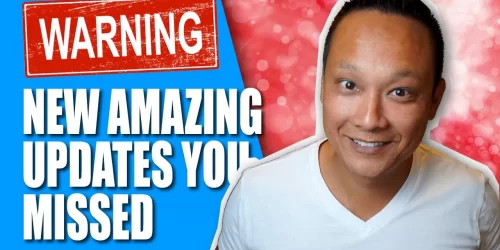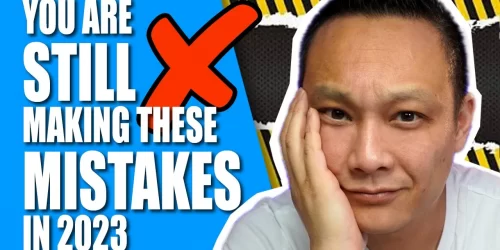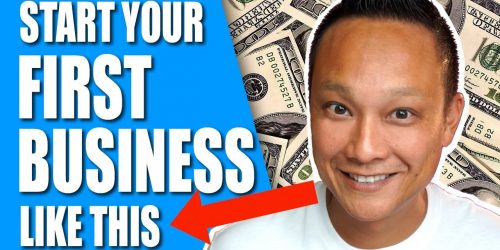Why Your FIRST Amazon FBA Product Will FAIL in 2022 | Mistakes to Avoid from the Start
What’s up guys, my name is Crescent. Did you know that over 20% of all new businesses fail within the first year? 45% within 5 years and 65% within 10? And this isn’t something new, this has been a common trend since the 1990’s. If you don’t want to end up being a part of this statistic, then you need to realize that you don’t know what you don’t know. So this video, I’m going to show you the top 5 reasons why Amazon sellers are failing so you can avoid being a statistic. And the first step to avoiding that is smashing the like button for the youtube algorithm because it helps to support this channel and it means the world to me but above all, it let’s Youtube know to show this video to more people just like you so they can go on to repeat the process. So, thank you, I really appreciate it. And with that said, let’s get started.
https://www.investopedia.com/financial-edge/1010/top-6-reasons-new-businesses-fail.aspx
Ok, so it was difficult to pick the first one to cover here because there are two huge reasons that are equally detrimental to the cause of failure. So, let’s just start by making sure that you’re even allowed to sell a product in the first place. I can understand how someone new to selling assumes that just because they see other people selling something that they can sell it too. Well no! In fact, that just isn’t true. That’s not how things work in the real world, unfortunately. First of all, Amazon has a list of prohibited products that you simply can not sell on their platform. Period. Second, they also have a list of restricted products and categories. These are products that require permission ahead of time in order for you to sell. These are typically referred to as gated categories. Some products may also need to meet specific compliance requirements which I’ll go over later on in the video. And third, many branded products will require you to provide proof that you purchased your inventory from a legitimate source such as providing a valid invoice. And outside of Amazon rules, many products are the intellectual property of someone else. That means they are trademarked or patented and require permission from the IP owner in order for you to sell or manufacture.
So, how can you make sure that the product you want to sell on Amazon that you’re actually allowed to sell it? Well first, Amazon has a list of gated categories and the requirements you need to meet in order to get ungated. Some are as simple as answering a few questions and you’ll get instant approval, whereas others may require you to meet certain criteria and submit additional documentation. Keep in mind too that some main categories that are ungated may have sub-categories that are gated.
Now, there’s also a list of all the prohibited products that aren’t allowed to sell on Amazon. So, these are products that you either outright can not sell on Amazon or they need to meet some sort of compliance requirement. How do you find out if they’re prohibited or require some sort of compliance? Well, here’s a list of prohibited products. I’ll leave a link to this in the video description below.
Restricted Products
https://sellercentral.amazon.com/help/hub/reference/200164570
https://sellercentral.amazon.com/help/hub/reference/200164330
As for product compliance, these are products that might need to have a Hazmat, FDA or CPC certification for example. Amazon actually just released a new compliance tool to make it easier for sellers to check if the product has any of these requirements. I’ll leave a link to this new tool in the video description below but it’s actually really simple to use. Just do a search for the products keyword and the tool will tell you what requirements are necessary for you to sell it on Amazon. For example, if you want to sell baby pacifiers, you can see that it says you need to have the following requirements. CPSIA as well as these certifications. Test reports that meet CPSA section 14 a5. A childrens product certificate or CPC. As well as a Test reports from a CPSC-accepted lab. Also be aware that if you don’t find your product using the tool, it doesn’t necessarily mean that there isn’t any requirements. Make sure you refer to the prohibited and restricted products pages as well as speak to a Seller Support agent to verify. Always do your due diligence.
Product Compliance
https://sellercentral.amazon.com/help/hub/reference/200301050
Compliance Tool
https://sellercentral.amazon.com/help/hub/reference/G2JX2MAWJ27DWAY6
https://sellercentral.amazon.com/ckp
Now as far as making sure you’re not violating anyone’s intellectual property, you can check yourself on USPTO.gov or hire an IP attorney to do a comprehensive search for you. I can’t express how important this is. Violating someone’s IP can get you into hot water, it’s no joke. In the best case scenario, you get a cease and desist and you’ll just get stuck with inventory you can’t sell. In the worst case you can get sued until the cows come home. I have a separate video that goes into this which I’ll leave a link in the video description below if you want to learn more about it.
USPTO
Alright, so moving on. Now, if you don’t get anything else out of this video, make sure you’re paying attention to this tip and that’s profit margin. I can’t count how many times I’ve spoken to new sellers that were in such a hurry to just find something to sell on Amazon that they didn’t bother to make absolutely sure that the product they’re selling actually makes them money. Remember, the whole point of starting your Amazon journey or any business is to make money [shark tank]. So, simply moving product that’s making zero profit is huge waste of your time. You need to 100% know your numbers. You need to know exactly what your costs and expenses are and make sure the product you’re selling has enough value that you can charge a high enough price to turn a respectable profit margin. Numbers like the manufacturing costs, shipping, duty, storage fees, packaging, labeling, advertising, Amazon FBA fees, and the estimated projected sales volume just to name a few. Now, if you don’t know what I’m talking about or what these numbers are before you go ahead and invest into a product, then you’re just gambling your money away. So how can you make sure you’re selling a product that has a high profit margin? Well, you need to differentiate and have a competitive advantage. You can’t just sell the exact same thing as everyone else. I’ll go over this in more detail in the next part of this video. But beyond that, in the current economy, I suggest selling high ticket products, especially products that are giftable and evergreen. Evergreen means it’s not a seasonal product or a fad. High ticket means, more expensive high end products. Products that typically cost $50 and higher. High ticket products inherently have higher profit margins and less competition due to the barrier to entry. Now, to help you with knowing the numbers, there are tools that you can use such as the Amazon FBA calculator and product research tools like Jungle Scout or Helium10. If you want to learn more about this, I have videos that go into detail on this and I’ll leave links in the video description.
Alright, so I already touched on this next tip earlier and that’s differentiation. With how competitive ecommerce is nowadays and how easy it is for buyers to shop and compare products right at their fingertips, it’s massively important that whatever you sell has some sort of competitive advantage. Gone are the days where you can simply sell the same widget as someone else and capture a piece of the pie. Buyers nowadays are looking to get the best value for their money so what that means for you is you need to offer a product that has better value than your competitors, and there are two ways you can do that. You can either offer a similar product at a lower price or you can offer a better product at a higher price. Which one would you choose? That’s actually a trick question. Never sell a product where you’re competing based solely on the price. If you have no other competitive advantage other than price, then all of your direct competitors will just end up in a price war, lowering their prices and driving the price lower and lower until no one ends up making any money. Don’t be lazy and fall into this trap. Always sell a product that has tangible value, that way you can charge more and increase your profit margin. Sell premium products of high quality. Fix a problem or add a feature, or my favorite way to differentiate, bundle the product with a bonus item. So, how can you find problems or features tha tyou can fix or bonus items that you can bundle? Great question! The best way is to just jump into the reviews of similar products and read what the buyers are saying. Look at the 3 or 4 star reviews and see if there are problems or suggestions there that you can act on to improve the product. You can also take a look at the frequently bought together section on the product listing for bundling ideas. Again, I have a video that goes into detail on how to differentiate and bundle and I’ll leave a link to it in the description below.
Alright, now speaking of traps, the next tip is avoiding bad product research data. Now, what do I mean by bad data? Well, when you’re doing product research, you’re looking for products that meet specific criteria such as high demand, low competition, minimum sales price, sufficient sales revenue, and a few other metrics. Now, the biggest trap I see so many beginners make is being lazy by just looking at the summary at the top of their product research tool like you can see here. If you didn’t know, these numbers up here are averages and can be very misleading. Basically, if you don’t know how averages are calculated, here’s a quick math lesson. Averages are calculated by adding up all the values that you have and then dividing the sum by the total number of values you added together. So for example, if we’re looking at the monthly sales figure, if there are 10 listings, then to get the average, you’d add up the monthly sales of all 10 listings and then divide by 10. And here’s where the average can be very misleading. Let’s say you’re aiming for a monthly sales figure of 500 sales per month. Well, if you’re looking at the top 10 listings, and each of the 10 listings is selling 500 units per month, then 500 x 10 = 5000. There are 10 listings, so you divide 5000 by 10 and you get an average of 500 units per month. Simple enough right? However, let’s say out of the top 10 listings, one listing sells 4100 units per month and the rest only sell 100. Well, 100 x 9 is 900. Add that to 4100 and you get 5000. Divide 5000 by 10 and you also get an average of 500 units sold per month. Can you see the problem here? Only one listing is getting all the sales. All the other sellers by comparison are getting no sales which is a huge red flag. You want to see that the sales are pretty evenly distributed amongst all the sellers so that you can have some confidence that you’ll be able to get a small piece of the pie as well. And this holds true when analyzing the other metrics, too. Never base any of your decisions on the summary here, always analyze the actual data. If you’re wondering what tool this is that I’m using here, this is Helium10, a powerful product research tool that you can actually try for yourself for free. I also have a coupon for my followers that will save you a ton of money that you can use. So, if you’re confused or you want to learn more about this, you can find the coupon and a link to a detailed product research video in the video description below.
Now, a pro-tip on avoiding bad data is identifying new listings and disregarding them from your analysis for sales and revenue. Why? Well, you need to remember that when a new product launches, the seller is typically selling the product at a lower price and aggressively bidding on PPC as well as other advertising and marketing strategies in order to boost their sales velocity. Therefore, those sales metrics are not organic and are most likely unprofitable, so the monthly sales and revenue figures you’re seeing are not realistic and in many cases give you the false impression that the niche has high demand and great sales. You need to be extremely careful and only consider listings that are at least 4-5 months old where their sales are most likely organic sales and represent what the true sales figures are for that niche. And a huge red flag is if you discover that there are a lot or the majority of the listings in a niche are new. This is a sign that the niche is saturated and that you should avoid it. Again, you can find a link to a product research video that goes into detail on all of this in the description below.
Ok, and the final tip I have for you to selling your first product on Amazon and that’s protecting yourself. In business, no one is looking out for your best interest so it’s up to you to always cover your own back. And the best way you can protect yourself is with knowledge. Just by being here and watching this video shows me that you’re proactive about learning about potential issues so that you can avoid them. And while you’re here, it would mean the world to me if you smashed the like button for the YouTube algorithm! And while I take a moment for you to do that, let’s continue. The real problem with learning is that you don’t know what you don’t know. There’s a popular saying, “You can learn from your own mistakes, but smart people learn from other people’s mistakes.” So, how can you learn from other people’s mistakes or experiences? Jump onto online communities like Facebook groups or Reddit forums and read. See what questions and problems other people are having and what the solutions are. Find a mentor that you resonate with and join their community or take their course. They’ve already been through it all and you can avoid making a ton of easily avoidable mistakes.
The second way to protect yourself is by protecting your money and there are several easy ways you can do that. First, although it’s not required to have a registered business to sell on Amazon, by setting up a business entity, it limits your liability in the case that your business goes under or if you happen to get sued. You don’t want to be personally liable or have your personal assets at risk like losing your house.
Always have detailed contracts in place that describe in detail the responsibilities of all of the parties involved so that there is no ambiguity about who needs to do what and by when. And when it comes down to paying for products or services, always pay using a method that offers you protection such as using Alibaba’s Trade Assurance, or using a credit card or Paypal. Never pay by bank wire transfer unless you’ve already established a long term working relationship with the other party.
And always manage your risk. If you’re spending several thousand dollars to have a product manufactured, it would be wise to spend a couple hundred dollars to have a product inspection done to make sure you’re getting what you paid for. This isn’t the time to try to save a few bucks. What if there was some miscommunication and the product color is off or if there is a misspelling on the packaging or worse? You want identify these problems right away and have your supplier handle this immediately before the product leaves their warehouse. Never try to do the inspection yourself. By the time the product gets to you, it will be virtually impossible for your supplier to take responsibility for anything you find wrong. And shipping the product back to your supplier overseas will end up being prohibitively expensive. The same holds true for shipping insurance. Products get damaged or lost all the time. Airplanes crash and ships sink. And you’d be surprised, insurance is extremely affordable. Typically, insurance to cover several thousand dollars worth of product costs less than $100. Remember, there are times to save money and there are other times when you should wisely spend it.
Now, as a bonus for sticking around all the way to the end of the video, I have a bonus tip for all of you and its something that most people don’t know about and that’s how you can save money with your Amazon business. Now, as with most of us, we’re dealing with suppliers from overseas such as from China. Well, if you’re having to convert your local currency into a foreign one or vice versa in order to pay or receive payments, you can be inadvertently losing a ton of money just on the conversion and exchange fees. So, instead of just going with your bank, credit card or other service like Paypal, Wise offers extremely competitive exchange rates and the lowest fees. You can also keep money in different currencies in your Wise account to avoid having to do any conversions altogether. This can add up to hundreds or thousands of dollars in savings. I’ll leave a link to a video that shows you exactly how you can save a ton of money this way down in the video description.
Wise Homepage: https://wi.se/crescentkao
You can also save a ton of money by combining your shipment of samples when your vetting suppliers. Instead of having each separate supplier send you a sample product, which can cost you around $75-100 each, have them all send the sample to a freight forwarder that has a local office in the country where all the suppliers are, like in China, and have the FF consolidate all of the samples into one package and ship all the samples together into a single shipment. This little tip alone will save you a ton of money.
And finally, this last tip is how I save a ton of money and take free trips around the world every year and that’s paying for all of my business expenses using a rewards credit card. This is the easiest way you can get a discount or rewards on the purchases you’re already going to make for your business. Typical rewards range from 1-5% off your purchases to points you can redeem for travel like hotel and airline tickets. Use the credit card for your business expenses. Link it to your Paypal account and use it to pay your supplier and for other services. And one of the best ways for Amazon is to pay for your PPC expenses with a rewards credit card rather than have Amazon deduct it from your revenue. You can change this in your settings in Seller Central by going to Settings > Charge Methods for Advertising > Change Payment Method > And select Credit or Debit Card. I’ll leave links in the video description below to a couple of the best credits cards that I use and recommend that have the best rewards and sign up bonuses like the American Express Gold card and Chase Saphire Preferred. Both of which have a sign up bonus right now of 60,000 points.
Alright, so if you want to get in touch with me, you can find all of my contact details in the video description below. I’d love to hear your thoughts, so leave a comment or question in the comment section below, I answer every single one.
And as always, if you found value in this video, consider subscribing. And do me a favor smash that like button for the youtube algorithm it really does help me out and I’d appreciate it, and ring the bell so you never miss a future video! Alright, thanks for watching!





